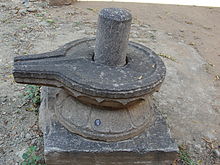



Ioni (en letra devanagari del idioma sánscrito, योिन), a veces llamado pindika, es una representación abstracta o anicónica de la diosa hindú Shakti.[1][2] Suele mostrarse junto a un linga, su contraparte masculina.[1][3] Juntos simbolizan la fusión del microcosmos y el macrocosmos,[3] el eterno proceso divino de creación y regeneración, y la unión de lo femenino y lo masculino que recrea toda la existencia.[2][4] El ioni se conceptualiza como la puerta natural de todos los nacimientos, sobre todo en las prácticas esotéricas kaula y tantra, así como en las tradiciones del shaktismo y shaivismo del hinduismo.[5]
Ioni es una palabra sánscrita que se ha interpretado en el sentido literal de «útero»,[4][6] la «fuente»[7]y los órganos femeninos de generación.[8][9] También connota los órganos sexuales femeninos como «vagina»,[2]«vulva»[10][11] y «útero»,[12][13] o alternativamente «origen, morada o fuente» de cualquier cosa en otros contextos.[2][14] Por ejemplo, el texto vedanta Brahma Sutras se refiere metafóricamente al concepto metafísico de Brahman como el «ioni del universo». La iconografía de ioni y linga se encuentra en templos de Shiva y yacimientos arqueológicos del subcontinente indio y el sudeste asiático,[15][16][17] así como en esculturas como las de Lajja Gauri.[18]
- ↑ a b Dasgupta, Rohit (26 de septiembre de 2014). Kimmel, Michael; Christine Milrod; Amanda Kennedy, eds. Cultural Encyclopedia of the Penis (en inglés). Rowman & Littlefield. p. 107. ISBN 9780759123144.
- ↑ a b c d Doniger, Wendy; Stefon, Matt (24 de diciembre de 2014) [1998-07-20]. «Yoni (Hinduism)». Encyclopædia Britannica. Edinburgh: Encyclopædia Britannica, Inc. Consultado el 22 de mayo de 2021.
- ↑ a b Beltz, Johannes (1 de marzo de 2011). «The Dancing Shiva: South Indian Processional Bronze, Museum Artwork, and Universal Icon». Journal of Religion in Europe (Brill Academic Publishers) 4 (1): 204-222. S2CID 143631560. doi:10.1163/187489210x553566.
- ↑ a b Lochtefeld, James G. (2001). The Illustrated Encyclopedia of Hinduism, Volume 2. The Rosen Publishing Group. p. 784. ISBN 978-0-8239-3180-4.
- ↑ Jones, Constance A.; Ryan, James D. (2007). «Yoni». En Melton, J. Gordon, ed. Encyclopedia of Hinduism. Encyclopedia of World Religions (1a. edición). Nueva York: Facts On File. pp. 260-261, 515-517. ISBN 978-0-8160-5458-9. LCCN 2006044419. OCLC 255783694.
- ↑ Indradeva, Shrirama (1966). «Correspondence between Woman and Nature in Indian Thought». Philosophy East and West 16 (3/4): 161-168. JSTOR 1397538. doi:10.2307/1397538., Quote: "Nature is my yoni (womb), [...]"
- ↑ Grimes, 1996, p. 361.
- ↑ Adams, Douglas Q. (1986). «Studies in Tocharian Vocabulary IV: A Quartet of Words from a Tocharian B Magic Text». Journal of the American Oriental Society (JSTOR) 106 (2): 339-341. JSTOR 601599. doi:10.2307/601599., Quote: "Yoni- 'womb, vulva', Yoni- "way, abode' is from a second PIE root [...]"; Indradeva, Shrirama (1966). «Correspondence between Woman and Nature in Indian Thought». Philosophy East and West (JSTOR) 16 (3/4): 161-168. JSTOR 1397538. doi:10.2307/1397538.
- ↑ , Cita: "yoni or womb [...]" p. 122, "[...] in the female aspect, it is known as yoni or female organ of generation [...], p. 175"
- ↑ Cheris Kramarae; Dale Spender (2004). Routledge International Encyclopedia of Women: Global Women's Issues and Knowledge. Routledge. p. 1840. ISBN 978-1-135-96315-6., Quote: "The sculpted image of the lingam usually stands erect in a shallow, circular basin that represents the yoni."
- ↑ Medical literature from India, Sri Lanka, and Tibet. Leiden: E.J. Brill. 1991. ISBN 90-04-09522-5. OCLC 24501435.
- ↑ Louis Renou (1939), L'acception première du mot sanskrit yoni (chemin), Bulletin de la Société de Linguistique de Paris, volume 40, number 2, pages 18-24
- ↑ Gerd Carling (2003). «New look at the Tocharian B medical manuscript IOL Toch 306 (Stein Ch.00316. a2) of the British Library - Oriental and India Office Collections». Historische Sprachforschung / Historical Linguistics. 116. Bd., 1. H. (1): 75-95. JSTOR 40849180., Quote: "[...] diseases of the yoni (uterus and vagina) [...]"; Shivanandaiah, TM; Indudhar, TM (2010). «Lajjalu treatment of uterine prolapse». Journal of Ayurveda and Integrative Medicine 1 (2): 125-128. PMC 3151380. PMID 21836800. doi:10.4103/0975-9476.65090., Quote: "[...] vaginal-uterine disorders (Yoni Vyapat) [...]"; Frueh, Joanna (2003). «Vaginal Aesthetics». Hypatia (Wiley) 18 (4): 137-158. S2CID 232180657. doi:10.1111/j.1527-2001.2003.tb01416.x.
- ↑ Monier-Williams, Monier. «Yoni». Harvard University Archives. p. 858. Archivado desde el original el 3 de marzo de 2009.
- ↑ Urban, Hugh B. (2009). The Power of Tantra: Religion, Sexuality and the Politics of South Asian Studies. I.B.Tauris. pp. 2-11, 35-41. ISBN 978-0-85773-158-6.
- ↑ Andrew Hardy, Mauro Cucarzi, Patrizia Zolese (2009). Champa and the archaeology of Mỹ Sơn (Vietnam). Singapore: NUS Press. ISBN 978-9971-69-451-7. OCLC 246492836.
- ↑ Lopez, Donald S. (1995). Religions of India in Practice. Princeton University Press. pp. 304–307. ISBN 978-0-691-04324-1. (requiere registro).
- ↑ Bolon, Carol Radcliffe (2010). Forms of the Goddess Lajja Gauri in Indian Art. Pennsylvania State University Press. pp. 40-47, 54. ISBN 978-0-271-04369-2.